Creating a multilingual, multicultural kamishibai: promoting diversity at school

A classroom project of this type can facilitate the acquisition of multiple skills. In this special unit for children newly arrived in France (UPE2A[1]), the development of this kamishibai[2] had three main objectives: to get the children involved in a competition, to develop several essential written and oral skills for the learners, and to enhance the diversity of languages and cultures at school by exploiting it. As a student in the Didactics of Languages Master's program at Inalco, I was able to integrate this plurilingual and pluricultural experience through an internship in an elementary school.
As a student in the Didactics of Languages Master's program at Inalco, I was able to integrate this plurilingual and pluricultural experience through an internship in an elementary school.
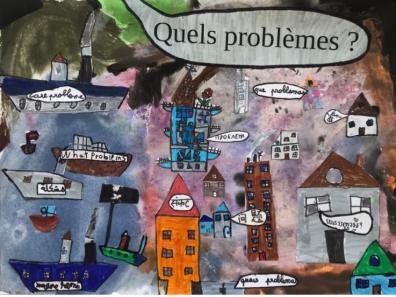
Participation in a competition
Participation in the "Kamilala" competition (2020-2021) run by the DULALA[3] association as part of a classroom project was a real source of motivation for the 19 learners, the 2 teachers, the trainee teacher and the parents. The aim of the competition was to create a multilingual kamishibai: a system of storytelling derived from Japanese art, corresponding to a set of illustrated boards read out in a small theater.
.
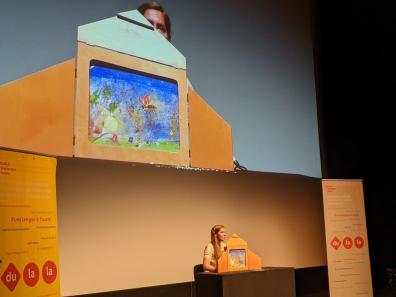
Fig. 2: Photo of the "What problems?" kamishibai reading at the Kamilala 2021 competition. Credit: D'Une Langue A L'Autre (DULALA). URL: https://dulala.fr. Paris. 2021.
In this Unité Pédagogique pour Élèves Allophones Arrivants (UPE2A), the production was carried out over 3 weeks. The first week was devoted to explaining the project to the children, and collectively choosing the theme, characters, title and so on. Inspired by Tom Tirabosco's phrase, the children told a story entitled "What problems?", with the aim of denouncing the disappearance of several species of animals on the planet.
The story was told by a group of children from the UPE2A group.
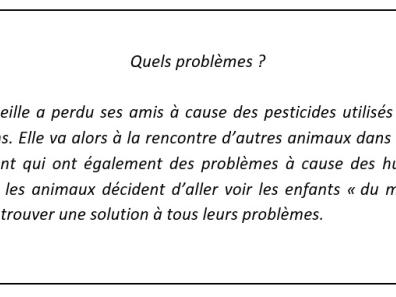
Then, during the second and third weeks, work focused on creating the illustrations with the help of the school's art teacher. The children used several artistic techniques: background, tracing, cutting, painting, etc. to create the nine plates that make up the story.
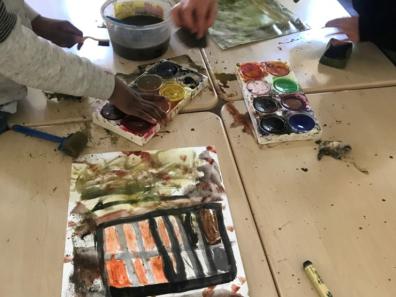
Fig. 3: Photo of kamishibai board preparation in the classroom. Photo by Barbara Fallon. Paris. 2021.
Also, during these two weeks, as we'll see below, the learners wrote the story using and developing their French language skills. And, these children from several countries were also able to exploit and share their languages and cultures of origin.
This competition combining artistic creation with linguistic and cultural diversity was a real source of motivation for the participants. It provided a framework and a collaborative space for creativity and expression, with the aim of achieving the same objective: to present a high-quality multilingual and multicultural kamishibai at the Kamilala competition. At the same time, several skills inherent to the project were developed.
Developing essential skills
Beyond the artistic aspect, the creation of this story made it possible to work on other essential skills, consistent with those of the national elementary school programs (2020), as well as those of the cadre européen de référence pour les langues (CECRL - 2001).
Skills in oral expression and comprehension in French were developed thanks to dialogues during the elaboration of the story, whether when it came to choosing the theme, the characters or when it came to choosing which languages and cultures to highlight in this work. At the same time, written expression and comprehension skills were worked on through individual and collective writing of the text. Finally, reading skills were also developed, as pupils were able to read their kamishibai in class. This last initiative spread the word about the project throughout the school, inspired other classes to try their hand at it, and enhanced the work of these UPE2A students. What's more, a video was made to present the kamishibai at the competition.
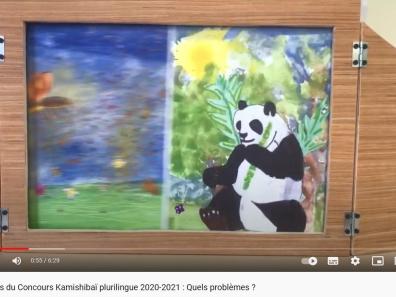
The "What problems?" kamisibai, narrated by the children in the class: https://www.youtube.com/watch?v=ZmIxVAGuyb0&t=1s. (Credit: YouTube channel of DULALA - D'une Langue A l'Autre. 2021.)
Work on the French language was therefore enriching at the level of reception (written, oral), production (written, oral), and interaction. At the same time, mediation was also at the heart of the learning process, notably through exercises using several languages and cultures (CEFR, 2001). Indeed, the children's own languages and cultures were used in several activities, so that they could play an active role and contribute their knowledge.
This artistic project falls within the scope of the didactics of plurilingualism and pluriculturalism, an approach that has been promoted by the Common European Framework of Reference for Languages since 2001. It corresponds to the use of several languages and cultures in the didactic and pedagogical practices of teachers. The creation of this story has therefore helped to develop plurilingual and pluricultural competence (Costes, Moore, Zarate, 1997) in students and teachers alike. For example, a number of linguistic comparison activities were carried out:
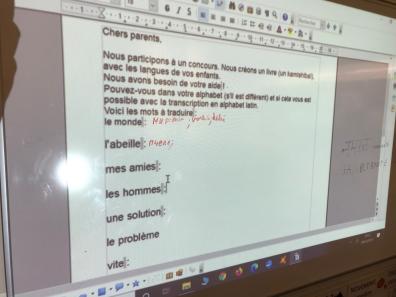
Here, learners had to bring in translations: how do you say "the world" in Soninke, in Romanian, how do you say "the bee" in Russian, in Khmer, and so on. These exercises, carried out several times during the process of creating the multilingual text, led to orthographic, phonetic, alphabetic and other comparisons. The aim of this type of activity is not only to use a child's linguistic and cultural repertoire, but also to compare it with that of other children. Metalinguistic awareness is developed: the aim is for the child to be able to transfer knowledge and know-how in several languages, and to develop several language system schemas (Castellotti, Moore, 2005). In addition to an openness to diversity, an awareness of how certain language systems work could enable the learner to better master foreign languages (Candelier, 2007).
This plurilingual and pluricultural kamishibai thus enabled the development of multiple knowledges, know-how, savoir-être and savoir-apprendre, but also highlighted the learners' primary languages and cultures in the school.
Valuing linguistic and cultural diversity
In conjunction with a school project that develops the skills detailed above, this creation opened up several children and adults to the linguistic and cultural diversity around them. This intercultural story, composed of thirteen different languages (Khmer, Chinese, Tamil, Hindi, Vietnamese, English, Portuguese, Spanish, Soninke, Arabic, Romanian, Russian and French), challenged the monolingual and monocultural representations sometimes instilled by French schools. Indeed, the overemphasis on French and French culture as a single language and culture is still very much present in discourse, representations and practices, to the detriment of valuing the linguistic and cultural diversity inherent in our environment (Castellotti, 2008). This system leads to problems of integration and linguistic and cultural insecurity for some learners.
Beyond the ecological aspect of the story created by the children, it's a subject that brings together several cultures, countries and continents, embodied by animals. The creation of this story led to dialogues and debates that introduced children, parents and teachers to other cultures and ideals. Certain representations were questioned, such as the place of children's first language(s) at school. This multi-actor project (teachers, children, parents) has had an impact and legitimized the use of foreign languages and cultures in school activities. Some children felt "liberated" to talk about their native countries and languages. For example, one Soninke-speaking child did not want to integrate his first language into the project. This refusal embodies the idea that pupils' first languages and cultures, other than French, have no place in French schools. But the arguments put forward by the teachers, the approval of the parents and the activities organized around this kamishibai freed this child's voice.
In addition, this creation was recognized in an unprecedented way, as it received an award from the DULALA association: this kamishibai was awarded the first prize 2020-2021 in the 6-10 year-old category at the 6th prize-giving ceremony held at the Maison du Japon in Paris.
The kamishibai was also awarded the first prize in the 6-10 year-old category at the 6th prize-giving ceremony held at the Maison du Japon in Paris.
The kamishibai was also awarded the first prize in the 6-10 year-old category at the 6th prize-giving ceremony held at the Maison du Japon in Paris.
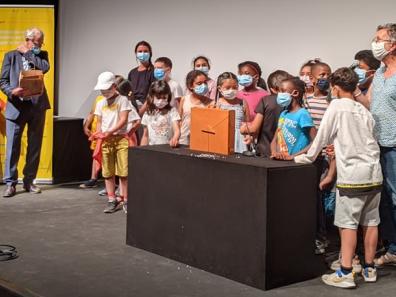
Credit: D'Une Langue A L'Autre (DULALA). URL: https://dulala.fr. Paris. 2021.
This "What problems?" kamishibai was then a source of motivation in learning, developing essential skills and challenging certain representations of linguistic and cultural diversity in the classroom. The prize-giving ceremony was seen by the school, the association and CASNAV Paris as a form of recognition. It also created a real buzz around this type of multilingual and multicultural experience in this elementary school. Such a playful project has brought a great deal of pride to its participants, and will perpetuate these reflections on linguistic and cultural diversity for future readers.
A big well done to all the elementary school's UPE2A students, as well as to the two teachers we worked with: Christine Pozzobon (UPE2A teacher), and Valérie Boccanfuso (art teacher). And, thank you to DULALA for promoting this kamishibai, by awarding it a prize at the 6th ceremony of the "Kamilala" competition (2020-2021).
You can view the story "What Problems?" narrated with the kamishibai by following this link: https://www.youtube.com/watch?v=ZmIxVAGuyb0&t=1s. (Credit: DULALA's YouTube channel - D'une Langue A l'Autre. 2021.)
Barbara Fallon, Master 2 Didactique des langues
This project was carried out as part of an internship for Inalco's Master Didactique des Langues (2021)
Bibliography
Candelier, M. 2007. "Éveil aux langues, formation plurilingue et enseignement du français". In Synergie Monde. p. 67-76.
Castellotti, V. 2008. "Au-delà du bilinguisme: quelle place en France pour une éducation plurilingue?". In Budach, G. Erfurt, J. and Kunkel, M., Écoles plurilingues - Multilingual schools: Konzepte, Institutionenen und Akteure. Frankfurt: Peter Lang. p. 169-189.
Castellotti, V. and Moore, D. 2005. "Répertoires pluriels, culture métalinguistique et usages d'appropriation". In Beacco, J. Chiss, J. Cicurel, F. and Véronique, D. Les cultures éducatives et linguistiques dans l'enseignement des langues. Paris : PUF, 107-132.
Council of Europe. 2001. Common European Framework of Reference for Languages: learning, teaching, assessment. Paris: Didier.
Coste, D. Moore, D. and Zarate, G. 1997 (reissued 2009). "Compétence plurilingue et pluriculturelle. Strasbourg: Council of Europe.
Dulala - Kamilala, accessed 26/12/2021. URL: https://kamilala.org/partner/dulala/
Dulala, consulted on 26/12/2021. URL: https://dulala.fr/
Fallon, B. 2021. "La place d'une perspective plurilingue et pluriculturelle dans le système éducatif français : le cas d'une école élémentaire parisienne". Master 2 dissertation "Didactique des langues du FLE et du FLS: métiers de la recherche, de l'enseignement et de l'ingénierie" under the direction of C. Peigné, year 2020-2021, INALCO. Paris.
Programmes Scolaires - Ministère de l'Éducation nationale, de la jeunesse et des sports, accessed on 26/12/2021. URL: https://www.education.gouv.fr/programmes-scolaires-41483
Notes
[1] In the French education system, an educational unit for newly arrived allophone pupils or UPE2A is a support system for allophone pupils included in ordinary classes.
[2] Kamishibaï literally means: "paper theater". It's a storytelling technique of Japanese origin based on images that scroll in a butai (wooden theater), equipped with small openings (or not).
A kamishibaï is made up of a set of numbered cardboard boards (generally between 11 and 15), telling a story. Each board depicts an episode in the story, with the illustration on the front and the text on the back. The boards are inserted into the lateral slide positioned at the back of the butai in the order of their numbering. By opening the butai's flaps, the audience discovers the illustrations, while the narrator reads the text, scrolling the boards one after the other in front of the spectators.
https://kamishibais.com/content/10-qu-est-ce-qu-un-kamishibai
[3] The Dulala association aims to use the multilingualism of our society as a lever to promote equal opportunities and combat discrimination.